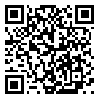BibTeX | RIS | EndNote | Medlars | ProCite | Reference Manager | RefWorks
Send citation to:
URL: http://rehabilitationj.uswr.ac.ir/article-1-611-en.html
Objective: We need lipreading tests in order to evaluate patient’s lipreading skills and necessary instructions. These are two kinds of lipreading test: synthetic & analytic. Sara (2) lipreading test is an analytic test and complementary of Sara (1) lipreading test which was a synthetic one (Movallali, 2000). Developing a lipreading test and standardization of the test in a group with normal hearing and vision was the aim of this study.
Materials & Methods: This study was a descriptive-analytical survey and its subjects included: 1) All Persian phonemes that were put in a VCV context. 2) 88 normally hearing and vision adults (58 males, 30 females) ranged from 17 to 85 years old).
Results: 1) “Sara Lipreading Test” (Number 2), composed of 23 nonsense two syllable VCVs. 2) Lipreading ability of Persian phonemes in 6 groups of homophones. 3) Subjects could distinguish between visems in 6 different homophone groups. 4) Content validity of the test. 5) No significant difference between test and retest.
Conclusion: According to the results of this study, “Sara (2) Lipreading Test” is a valid and reliable analytic test for assessing lipreading ability of Persian phonemes and despite of its simple structure, gives us a lot of valuable information about lipreading skills and is complementary of synthetic lipreading tests.
Received: 4/09/2010 | Accepted: 18/10/2015 | Published: 18/10/2015
| Rights and permissions | |
 |
This work is licensed under a Creative Commons Attribution-NonCommercial 4.0 International License. |





